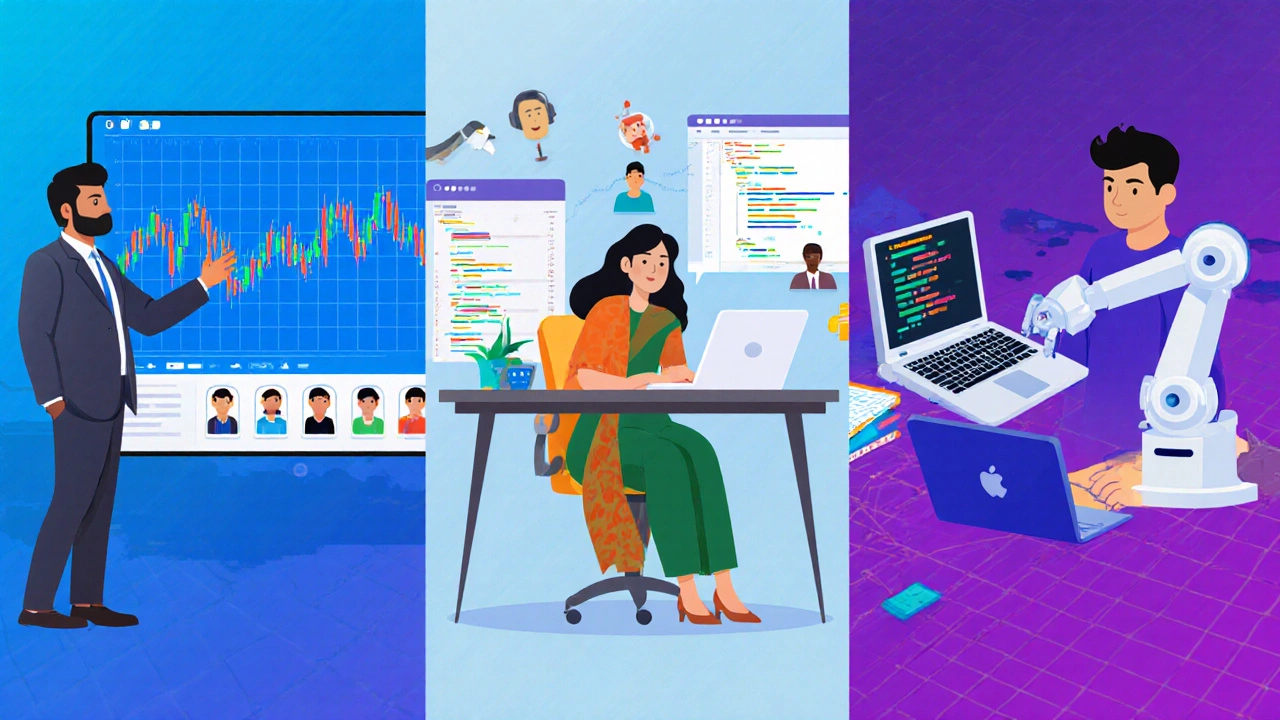Everyone wants a shortcut to the stock market, but the real shortcut is a teacher who can break complex concepts into bite‑size steps. In India the market’s sheer size and the flood of online courses make it hard to tell which mentor actually delivers results. This guide cuts through the hype, shows you the criteria that matter, and ranks the three most successful trading teachers as of 2025.
Key Takeaways
- Look for teachers with at least five years of consistent trading profitability and transparent track records.
- Live interaction, a structured curriculum, and a community of active students are the three non‑negotiable features.
- The top three Indian trading teachers in 2025 are Rohit Kelkar, Priya Sharma, and Vikash Gupta - each excelling in a different niche.
- Pricing varies widely; understand what you’re paying for before you sign up.
- Avoid “get‑rich‑quick” promises and focus on teachers who emphasize risk management.
What Makes a Trading Teacher Worth Their Salt?
Before we name any mentor, it helps to know the exact qualities that separate a genuine educator from a hype‑machine. Below are the six attributes you should verify for any trading teacher who offers structured market education, proven performance, and a supportive learning environment:
- Verified Track Record: Look for at least five years of personal trading profit, backed by broker statements or audited results. A teacher who can show a consistent 10‑15% annual return over different market cycles demonstrates real skill.
- Curriculum Depth: A good program covers basics (market mechanics, order types), intermediate topics (technical analysis, options greeks), and advanced modules (algorithmic strategies, portfolio construction).
- Live Interaction: Real‑time webinars, Q&A sessions, and one‑on‑one coaching ensure you can ask follow‑up questions when you hit a roadblock.
- Community Support: Private Discord or Telegram groups where students share trade ideas, post screenshots, and celebrate wins create accountability and peer learning.
- Risk Management Emphasis: The best teachers spend as much time on position sizing and stop‑loss placement as they do on entry tactics.
- Transparent Pricing & Refund Policy: Clear cost breakdown, trial periods, and a money‑back guarantee protect you from hidden fees.
Top 3 Trading Teachers in India (2025)
After scoring dozens of mentors against the checklist above, three consistently outperformed the rest. Below you’ll find a snapshot of each teacher’s background, teaching style, and what students say.
- Specialty: Intraday equities & options
- Format: Live webinars (Mon‑Fri), recorded modules, weekly strategy review
- Price (2025): INR 49,999 for the full 12‑week program
- Student Success Rate: 68% report consistent profits after 6 months
- Specialty: Futures & commodity trading
- Format: Hybrid - live weekly masterclass + daily Q&A chat
- Price (2025): INR 39,999 for the 10‑week intensive
- Student Success Rate: 72% report reduced losses and steady gains
- Specialty: Algorithmic & swing trading
- Format: Recorded video lessons + live code‑review sessions
- Price (2025): INR 59,999 for the 8‑week bootcamp
- Student Success Rate: 55% launch a profitable bot within three months

Side‑by‑Side Comparison
| Attribute | Rohit Kelkar | Priya Sharma | Vikash Gupta |
|---|---|---|---|
| Years of Trading Experience | 12 | 10 | 8 |
| Primary Market Focus | Equities & Options | Futures & Commodities | Algorithmic Swing |
| Course Length | 12 weeks (live + recordings) | 10 weeks (hybrid) | 8 weeks (recorded + live code reviews) |
| Live Interaction Frequency | Daily (Mon‑Fri) | Weekly masterclass + daily chat | Bi‑weekly code review |
| Community Size (2025) | 4,200+ | 3,500+ | 2,800+ |
| Average Post‑Course Profit Increase | 12% | 10% (drawdown reduction 30%) | 25% (bot‑based returns) |
| Price (INR) | 49,999 | 39,999 | 59,999 |
| Refund Policy | 30‑day money‑back | 45‑day money‑back | No‑refund after 7 days |
How to Pick the Right Teacher for Your Goals
Even the best mentor won’t work for everyone. Use the following decision tree to match your personal profile with the right teaching style:
- Identify Your Market Preference: If you love fast‑pace intraday action, Kelkar’s equity‑focused program fits. If you prefer longer‑horizon contracts and want to master position sizing, Sharma’s futures academy is better. If you enjoy coding and want a systematic edge, Gupta’s algorithmic bootcamp is the way to go.
- Assess Your Time Commitment: Daily live sessions require at least 1-2 hours each weekday. Hybrid or recorded formats give more flexibility but need self‑discipline.
- Set a Budget Ceiling: Prices range from INR 40k to 60k. Remember that higher cost often includes more personalized coaching.
- Try a Free Trial: All three teachers offer a short introductory webinar. Attend and note the clarity of explanations, responsiveness to questions, and the vibe of the community.
- Check Real‑World Results: Request recent trade logs or student case studies. Authentic mentors will share anonymized screenshots; vague “testimonials only” are a red flag.

Common Pitfalls to Avoid
Even after choosing a reputable mentor, beginners can stumble. Here are three traps that wipe out gains fast:
- Over‑Leverage: New traders often crank up the leverage after a few wins, only to see a single loss wipe the account.
- Skipping the Trade Journal: Without documenting entry, exit, and rationale, you can’t learn from mistakes.
- Chasing “Hot Picks”: Trust the teacher’s framework, not the hype around a single stock tip.
Stay disciplined, stick to the risk rules, and treat every trade as a data point for your learning curve.
Quick Checklist Before Enrolling
- Verified 5+ years of personal profit
- Clear curriculum with live and recorded components
- Active student community (≥3,000 members)
- Transparent refund or trial policy
- Risk‑management module included
Frequently Asked Questions
What should I look for in a trading teacher’s credentials?
Verify at least five years of consistent personal trading profit, preferably with broker‑verified statements. Look for certifications (NISM, CFA) and a transparent track record of student performance.
Do I need a large capital to start with these courses?
Most Indian mentors design strategies that work with a minimum of INR 50,000 for equities and INR 1 lakh for futures. The key is proper position sizing, not raw capital.
Are live webinars recorded for later review?
Yes. All three top teachers archive their live sessions in a private portal, so you can revisit concepts at any time.
How long does it take to become consistently profitable?
Consistency typically appears after 4-6 months of disciplined practice and journal‑keeping, assuming you follow the mentor’s risk rules.
What is the refund policy if the course doesn’t meet expectations?
Rohit Kelkar offers a 30‑day money‑back guarantee, Priya Sharma provides 45 days, while Vikash Gupta has a 7‑day no‑refund window. Always read the fine print before paying.
Choosing the right mentor is the first step toward turning market knowledge into real money. Use the criteria, compare the top three teachers, and run a short trial before committing. With disciplined practice and the right guidance, you’ll be on a steady profit path faster than you think.
